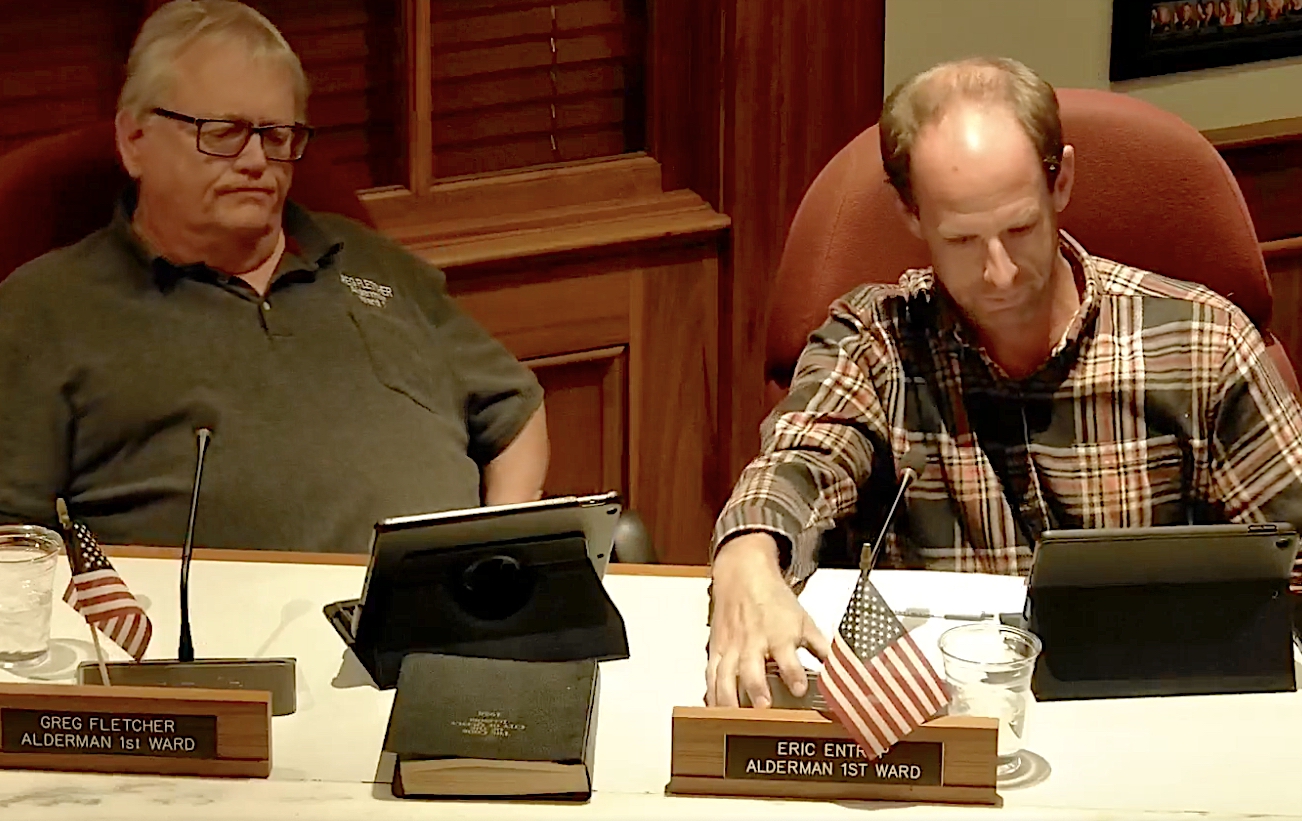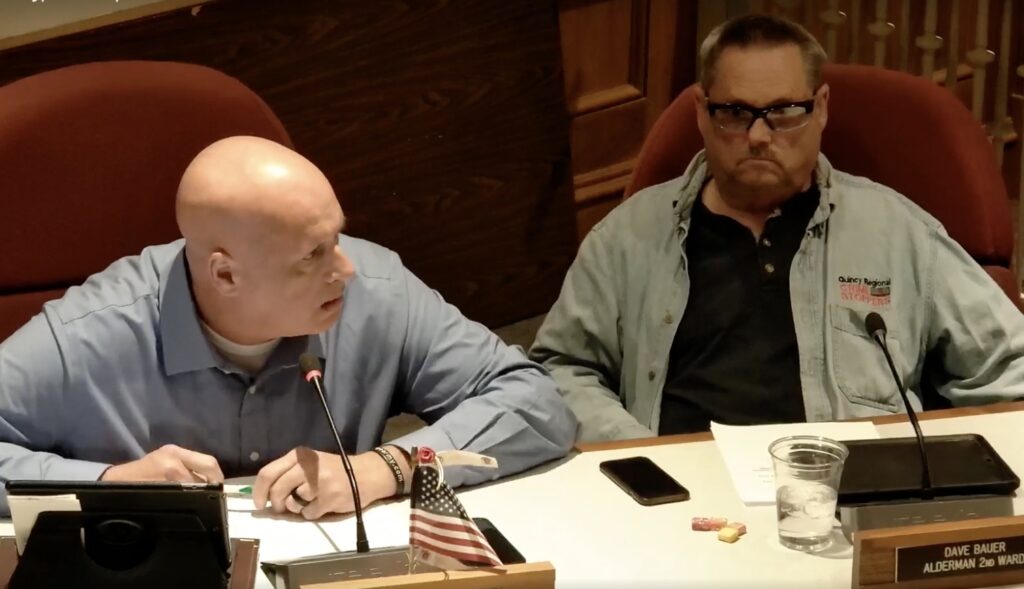Going ’round in circles: After defeating roundabout in April, City Council switches gears, OKs $5.2 million project

QUINCY — Jack Holtschlag (D-7) said he didn’t know how the vote would go when he made a motion to have another vote for the City of Quincy to partner with Adams County to build a roundabout at the intersection of 48th and State.
“I go by there three or four times a day, and not a time goes by when I don’t see someone walking or on a bike,” he said. “I know it’s going to cost a lot of money, but there’s a lot of work there.”
Eric Entrup (R-1) said “people have been talking” since the Quincy City Council voted 9-5 in April not to partner with the county on the roundabout.
“I guess we decided to go ahead and try tonight,” he said. “I think the one thing that (all of the aldermen agree) on is we didn’t want (the issue) to come back after tonight. We didn’t want to talk about it anymore.”
In a surprising reversal, the City Council voted 8-6 Tuesday night to share costs with the County Board on the roundabout’s construction.
Six aldermen who voted in April against the project kept their votes the same on Monday — Greg Fletcher (R-1), Jeff Bergman (R-2), Dave Bauer (D-2), Tony Sassen (R-4), Mike Rein (R-5) and Richie Reis (D-6). Five aldermen who voted in April to support the project kept their votes the same on Monday — Entrup, Ken Hultz (R-3), Jake Reed (R-6), Ben Uzelac (D-7) and Holtschlag.
The three swing votes came from Kelly Mays (R-3), Mike Farha (R-4) and Glen Ebbing (R-5).
Asked after the meeting why he changed his mind, Farha said, “I didn’t hear anything. They’re going to keep coming. This will be offset by the cost the county is willing to pay, and they’re just going to keep coming. Then when we have to do it, we’ll end up having to do the whole thing.”
“The county and the city have never gotten along. I think it’s worth trying. It’s education. John Wood (Community College) wants it, and that makes a difference.”
After the conclusion of Tuesday’s Adams County Board meeting, Board President Kent Snider said, “It was never about the roundabout. It was about the safety of kids going to John Wood Community College.”
The resolution placed on the agenda for Monday’s meeting called for amending a 1973 jurisdictional agreement between the city and the county regarding the transfer of maintenance responsibilities at the intersection. The Finance Committee voted Oct. 1 to send a resolution to the full City Council that called for the city would assume the State Street portion of the agreement, but it would only assume South 48th from Broadway to 300 feet south of State. The county would have retained jurisdiction of the remaining portion of South 48th, including a pipe culvert and embankment that need approximately $500,000 in repairs.
County officials have always maintained they preferred to build the $5.2 million roundabout, with the county paying $3.25 million and the city paying $1.95 million. The costs originally were to be shared evenly, but the county recently offered $650,000 to the city to compensate for additional jurisdictional transfers of sections of Seminary Road and North 18th.
Holtschlag made the motion to construct the roundabout with shared costs and the $650,000 transfer. Entrup seconded the motion.
“Did this council not kill the roundabout about two months ago?” Fletcher asked. “Tonight’s resolution is Plan B, which came out of (the Finance Committee). I feel like that’s what we should be voting on. … If you’re going to vote on the roundabout, I think it needs to go back to committee and then come back at a later date.”

“I’d rather not send it back to committee,” Bergman said. “My thought is no. Not only no, but hell no on this roundabout. I’m tired of it. We’ve got more important things in town to worry about infrastructure-wise than to worry about the roundabout, plain and simple. I’d rather have a vote tonight. Be done with it. Be done with this roundabout.”
However, after aldermen voted 8-6 to amend the resolution to say the city would share the roundabout cost, more discussion ensued. Bergman asked Comptroller Sheri Ray and Director of Public Works Jeffrey Conte where the funds to pay for the city’s portion would come from.
Ray said that when aldermen passed a bond issue in 2019, the roundabout was one of the projects that was planned. A city budget document shows $1.793 million remains unspent in the street projects fund.
“There was $2 million in the original budget with the bond proceeds,” Conte said. “We’ve done all the other projects. That one was not done. The money is still sitting there, waiting to be allocated for something.”
Bauer asked Conte if any of the money was to build bike paths and sidewalks to address safety issues at the roundabout. Conte said no. Engineering Manager Steve Bange said the plans call for curbs, gutters and a wider shoulder from 48th Street south to the top of a hill — still several hundred feet short of the entrance to JWCC.
“You could call it a bike path, but it will not be striped as a bike path,” Bange said.
“You’re gonna have a bike path that goes nowhere,” Bauer said.
“It’s similar to Payson Road in front of (Lincoln-Douglas Elementary) School,” Bange said. “That’s not classified as a bike path, but if you really had to put a bike path symbol down, you could. it’s wide enough for bicycles to use, but it’s not necessarily a bike path.”
Conte later said he believed JWCC would attempt to get grant funds to complete a bike path and a sidewalk from the top of the hill to the JWCC entrance.
The county and city already have spent approximately $490,000 on engineering and land acquisition for the roundabout.
Conte also said the city will spend $275,000 from its water fund to replace a water main as part of the project. He said approximately $205,000 must come from next fiscal year’s capital fund budget.
“The roundabout itself is not $5 million,” Conte said. “The roundabout itself is probably closer to $2 million. To do the north leg, the south leg, the east and the west and the culvert, there’s where you get to the $5 million.”
“As far as the council goes, this is a want. It’s not a need,” Bergman said. “Unless each one of you aldermen can sit there and tell me and tell your residents in your ward that you don’t have any infrastructure needs that are important and we can focus on this instead, then you vote that way. The 2nd Ward doesn’t have that luxury.”
Addressing Entrup, his fellow 1st Ward alderman, Fletcher said, “I’m sorry, Eric, but there ain’t nobody in my ward who wants to be part of this thing. … I cannot support this, and I challenge my colleagues. Maybe just Wards One and Two have the crappiest streets in town. Maybe you guys, the streets are all in great shape. Mine, there’s no way I can support this.”
Farha said the issue has “continually come up” during his aldermanic tenure, now at 36 years.
“I have a question for all the aldermen. What if we’re wrong?” he said. “What if this would efficiently carry traffic. You have a large number of taxpayers across the street. You have all kinds of issues with traffic that way. I’m willing to give it a chance. I don’t like the money. I don’t like dealing with the county. I’d sooner deal with the mafia. Seriously, I don’t care. I think (the city should) at least try it, and if it’s wrong, they’ll know. And if it’s wrong, we fail. We fail. It’s not the first time we’ve failed.
“The hydro dam was a failure, but a lot of us voted for it. It was a noble failure. I don’t think this will fail. Whether it works as well as they think, I can’t bear witness to that. I’m just tired of arguing. The community looks at this, and we’re arguing over accounting and we’re arguing over all this stuff. I just think we ought to vote.”
Entrup said after the meeting that he wanted to take advantage of the rare opportunity to build a road when the county is paying more than 50 percent of the project.
“The thing that rang true to me the whole time was that the jurisdictional transfer is a real document,” he said. “It’s a legal document. I’ve seen no lawyer and nobody in the legal department tell me that that thing is not a binding contract. There’s nothing in it that says anything about the amount of money you need to be given to do that agreement.
“To me, we were going to be taking over that whole chunk of land with virtually nothing given to us if we wanted to go the other direction. Then some point down the way, 10 years or whatever, we were going to have to spend money to improve that intersection. … I never wanted to turn that money down. I had no real reason to think that we should turn it down just because it didn’t fall directly into our schedule.”
Miss Clipping Out Stories to Save for Later?
Click the Purchase Story button below to order a print of this story. We will print it for you on matte photo paper to keep forever.

